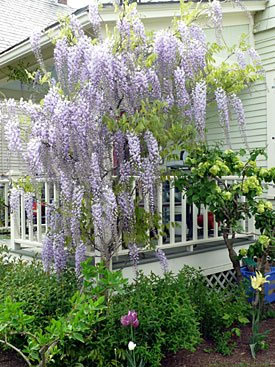






When I started working at Gardener's Supply in the 1990s, my Vermont backyard was pretty green—with grass. Today, there's just a tiny bit of the original lawn left. Most of the available space has given way to trees, shrubs, perennials, annuals and stonework. Watch a slideshow of my garden in Burlington, VT.
In addition to my work at Gardener's Supply, I work in the gardening division at Church Hill Landscapes. In that role, I maintain dozens of gardens and learn a lot in the process. I believe that all gardening is good gardening.

Wisteria floribunda 'Lawrence' in its fifth year in my garden. The variety was discovered in Canada, and it gets hardiness ratings of 4 or 5.
When it blooms, the vigorous wisteria vine is spectacular. But it doesn't always perform on cue. You can find all kinds of wisdom out there, but to my mind, the key is pruning. Once you've figured that out, you'll be rewarded in spring. In The Pruning Book (The Taunton Press), Lee Reich recommends a combination of summer and winter pruning of side shoots. In midsummer, prune each side shoot to about 6 inches long. This will trigger growth of new shoots. Go over each of these branches again in late winter and shorten them to two or three buds.
In other words, identify a few primary branches. For instance, if you want to train the vine over an arch or along the edge of a porch, pick one vine. Then, edit all the redundant vines. It might seem harsh, but this vine is vigorous and will push you around if you don't assert yourself. After you've identified the primary branches, you can begin pruning the side shoots: once in midsummer; once in winter. The idea is to create lots of short spurs all along the main vines. Again, be assertive.
Other things to know about wisteria:
For a detailed presentation on wisteria pruning, check out the video, below, featuring Alan Titchmarsh of the BBC.
Copyright © www.100flowers.win Botanic Garden All Rights Reserved